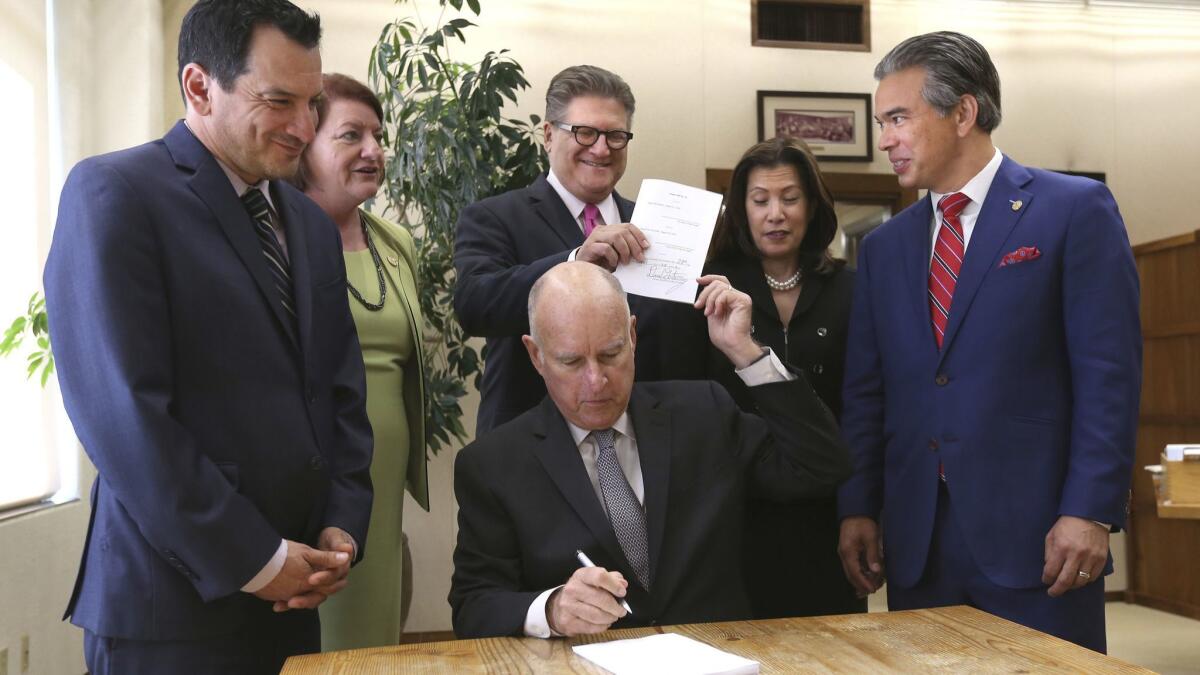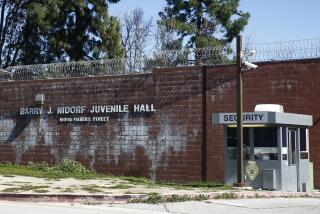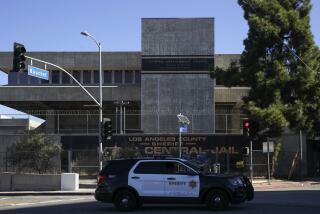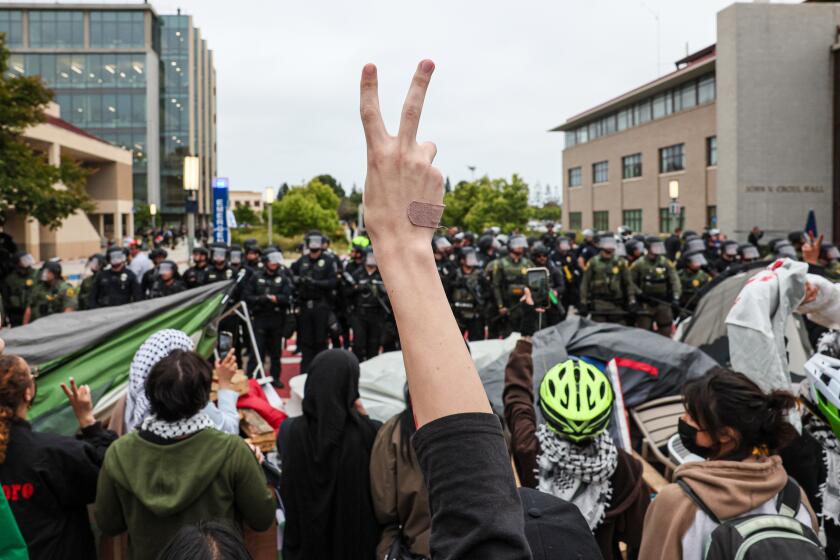With California’s cash bail system in limbo, Compton pilot program serves as a ‘petri dish’

Judge Pat Connolly wrinkled his eyebrows as he listened to the UCLA law student’s request.
Her client, Stevie Elkins, had been homeless for five months before his July arrest on a robbery charge, Taylor de Laveaga said. He couldn’t afford $25,000 in bail — really, de Laveaga said, he couldn’t afford anything.
The judge lowered his chin, locking eyes with Elkins, 50, who sat hunched at the defense table inside the Compton courtroom.
“Mr. Elkins,” Connolly said, “you’re not going to burn me on this are you?”
“No, I will not,” he said.
Connolly nodded, explaining that he would drop Elkins’ bail to $0 under the condition he spent the time until his case was resolved at a live-in drug and alcohol treatment facility.
Since September, judges in the Compton Courthouse have received several such bail-reduction requests as part of a new collaboration among UCLA law students, the Los Angeles County public defender’s office in Compton and the Bail Project, a nationwide fund used to post bail for indigent defendants.
The pilot project in Compton — which its founders characterize as a small but important step in reversing structural racism and economic inequality in the legal system — comes during a critical time for the future of bail in California.
Gov. Jerry Brown signed a law in the summer abolishing cash bail and replacing it with a system that grants judges more power to decide who should stay behind bars before trial. But the fate of the reform is in limbo, after a coalition of bail bonds groups appear to have gathered enough signatures to force a referendum vote. If the signatures are verified, the law, which would have taken effect in October, will be suspended until 2020, when voters will decide whether to overturn it.
“It almost feels like we are the single petri dish in L.A. County during this time,” said Jane Newman, the head deputy of the public defender’s Compton branch. Compton is the right place for the pilot program, she said, noting that roughly 7 out of every 10 clients the public defender’s office represents there can’t afford bail and therefore sit in jail before trial while their lawyers fight their case.
“Those are people who are presumed innocent!” Newman said, shaking her head in frustration.
Dist. Atty. Jackie Lacey said the program is an encouraging step away from what has long been the status quo in L.A. County: If you have money, you bail yourself out; if you’re poor, you don’t.
“I believe that that’s wrong,” she said. “Anything we can do … so people aren’t punished for being poor is something prosecutors ought to support.”
She acknowledged that prosecutors have long had a “standard response” about defendants at bail hearings: “They’re a flight risk, they’re a danger.” That’s what prosecutors were trained to say, Lacey said. But she said there are less restrictive methods for ensuring someone shows up to court — wearing an ankle monitor, for example. As for public safety, Lacey said she would worry primarily about defendants accused of domestic violence.
“As the prosecutor,” Lacey said, “you’re always worried when you look at the paper first thing in the morning that someone got out and hurt someone. We’re constantly concerned.”
The pilot project was born out of a chance meeting in the spring between Newman and Robin Steinberg, who founded the Bail Project, as well as the Bronx Defenders, a law office that provides criminal defense attorneys to low-income defendants.
Newman’s bosses eventually approved the three-way partnership, which relies on law students from UCLA Law School’s criminal justice program, where Steinberg works as a senior fellow.
So far, the team has successfully secured bail reductions and pretrial release for 11 of the 14 people they’ve helped, Steinberg said, adding that discussions are underway to expand the program beyond Compton.
Three men, including Elkins, were released without bail under the condition they went to a rehabilitation facility, and several defendants were released on their own recognizance after initially being held on bail as high as $105,000 for charges including stalking and injuring a spouse or cohabitant. In four cases, Steinberg said, individuals were released after judges drastically reduced their bail amounts and Bail Project employees — “bail disruptors,” as they call them — showed up at the courthouse with money from the nationwide fund.
Asking for bail reductions got easier, at least in theory, in January, when a panel of state appellate justices ruled that judges should consider a defendant’s ability to pay bail.
“A defendant,” the panel wrote, “may not be imprisoned solely due to poverty.”
But there’s a disconnection between the law on the books and what actually happens in courtrooms across the state, Steinberg said, noting that a judge’s nightmare is learning that someone they released on bail committed a heinous crime while out of custody.
“We’re hoping to sort of begin to shift the culture and begin to prove to judges, ‘You can do this and nothing bad is going to happen,’” Steinberg said.
For some clients, getting bailed out means that for the months, and sometimes years, before a case goes to trial, they can maintain their daily routines, such as going to work and caring for their children. They also have freedom to make a reasoned decision on whether to accept a plea deal.
“Rich people get to do that all the time,” Steinberg said. In the four cases that have reached a final court disposition in Compton, the clients struck plea deals that required either probation or time-served sentences, rather than jail sentences — an indication, Steinberg argues, “that people achieve better case outcomes when they can make decisions with their public defenders based on law and evidence, rather than desperation.”
Since bail money is eventually returned as long as a person shows up for court, the Bail Project’s national fund, which is bankrolled by philanthropists, operates as a revolving pot of money. At their pilot site in the Bronx — the model used to expanded nationwide — the same dollar bails out two or three people, Steinberg said, and over 10 years, nearly 96% of the people bailed out showed up for court hearings.
In Compton, she said, all of the clients who have been released so far have shown up for court, which doesn’t surprise her. People don’t need the threat of losing money to show up, Steinberg said, they need practical support. They need reminders about court dates and help coordinating transportation and childcare.
If the new state law takes effect in 2020, Steinberg will be among its critics — it’s simply swapping one discriminatory system for another, she said.
Under the law signed by Brown, each county would implement its own risk-assessment tools to evaluate arrestees and determine whether, and under what conditions, they should be released before trial. But opponents such as Steinberg say those risk-assessment tools inevitably rely on historical group data that are biased against communities of color.
Steinberg also worries that judges could implement probation-like conditions on defendants before they’re convicted — giving them curfews or requiring drug testing.
“I worry that those kinds of conditions will wind up forcing people back into jail cells,” she said.
Bail bondsman Greg “Topo” Padilla also opposes the new state law. But he criticized the Bail Project model, saying it would be impossible to implement on a large scale considering high bail amounts in California.
“Their endowment would have to have the B-word in it — billion,” said Padilla, president of the Golden State Bail Agents Assn.
Those released on their own recognizance or bailed out with money from a philanthropist simply don’t have as much to lose as someone who posts their own bond — or someone, he said, who knows how hard their mother or aunt worked to put up the money.
“That is pure 100% common sense,” Padilla said. “They have skin in the game.”
In another Compton courtroom, Tommy Galvan, who was charged with joyriding, faced a $70,000 bail. Law student Alexandra Trantham asked the judge to instead release Galvan on his own recognizance. He had a criminal record, she acknowledged, but all of his charges stemmed from his drug addiction.
“Mr. Galvan was not good at asking for help,” Trantham said. “But the man who’s here today is a different man.… He is not a risk to public safety.”
On the witness stand, Galvan’s 23-year-old sister said he could live with her while he awaited trial. He could care for his 5-year-old daughter, who was now living with her, and help care for their ailing mother.
The prosecutor vehemently opposed releasing Galvan without bail, arguing the money was necessary “to ensure he would come back.”
Trantham assured the judge Galvan would return for court — he would receive text message reminders from employees at the Bail Project in the days leading up to his court hearing, she said.
The judge acknowledged that Galvan clearly had a drug issue and encouraged him to get help, but denied the request to reduce his bail that day. Instead, the judge said, he’d give Galvan’s legal team a week to find him a spot at a live-in drug program. If they found a place, he would consider releasing him to the facility without bail.
Outside the courtroom, Trantham posed for a photo with her collaborator, Galvan’s deputy public defender. When another attorney from the office spotted them posing, she asked, “Another win?”
Kind of, they explained.
She flashed a thumbs-up.
For more news from the Los Angeles County courts, follow me on Twitter: @marisagerber
More to Read
Sign up for Essential California
The most important California stories and recommendations in your inbox every morning.
You may occasionally receive promotional content from the Los Angeles Times.











